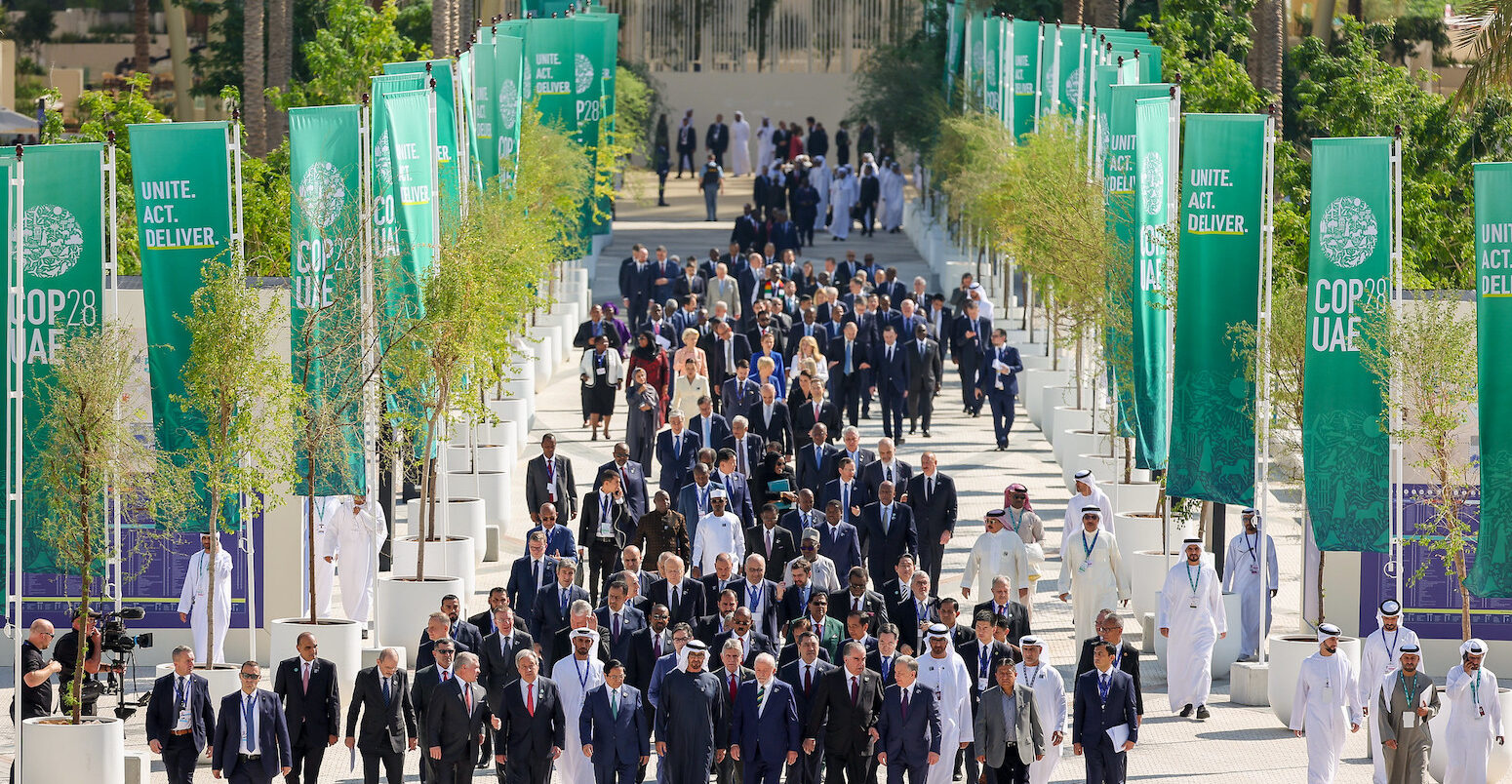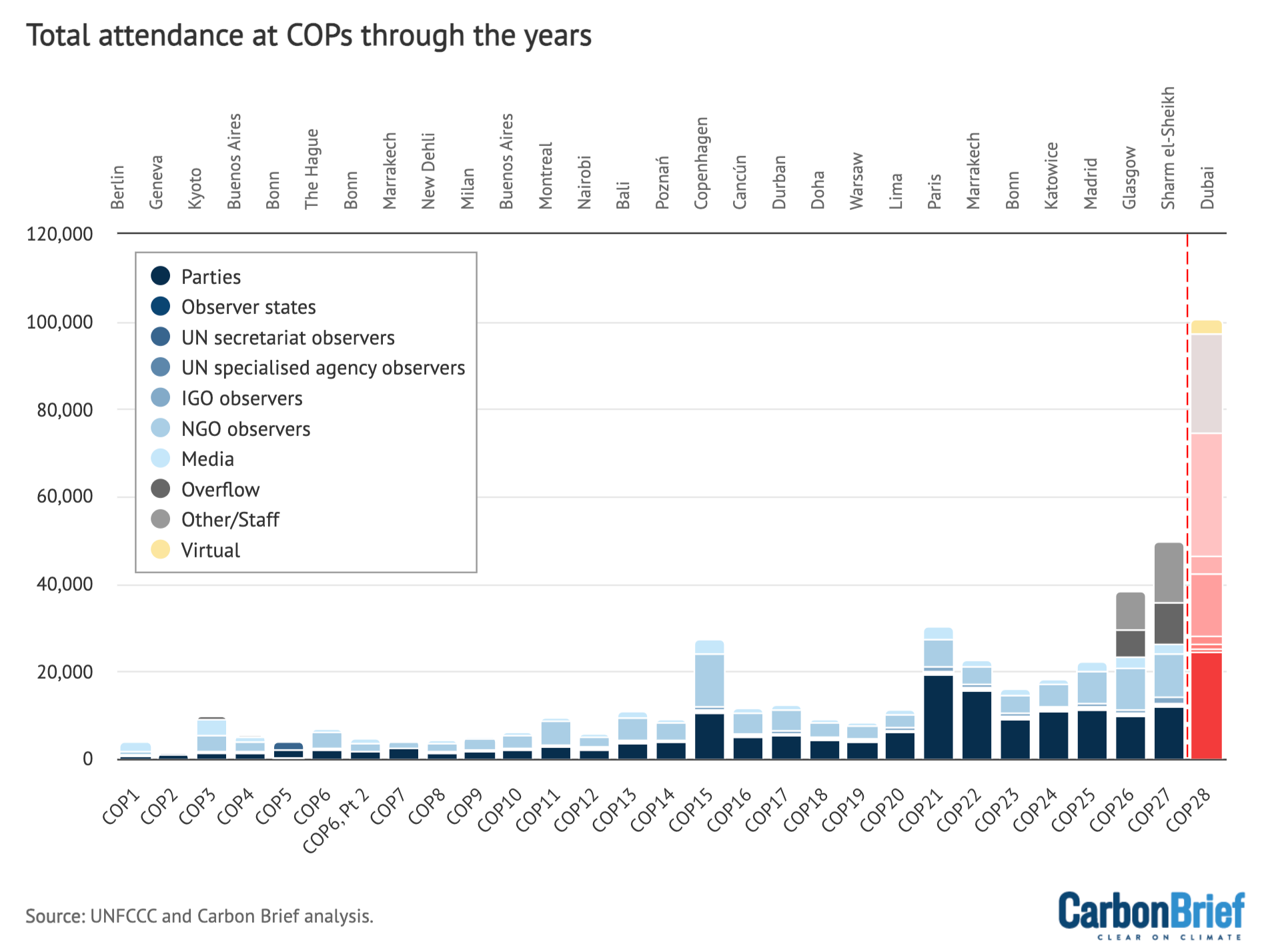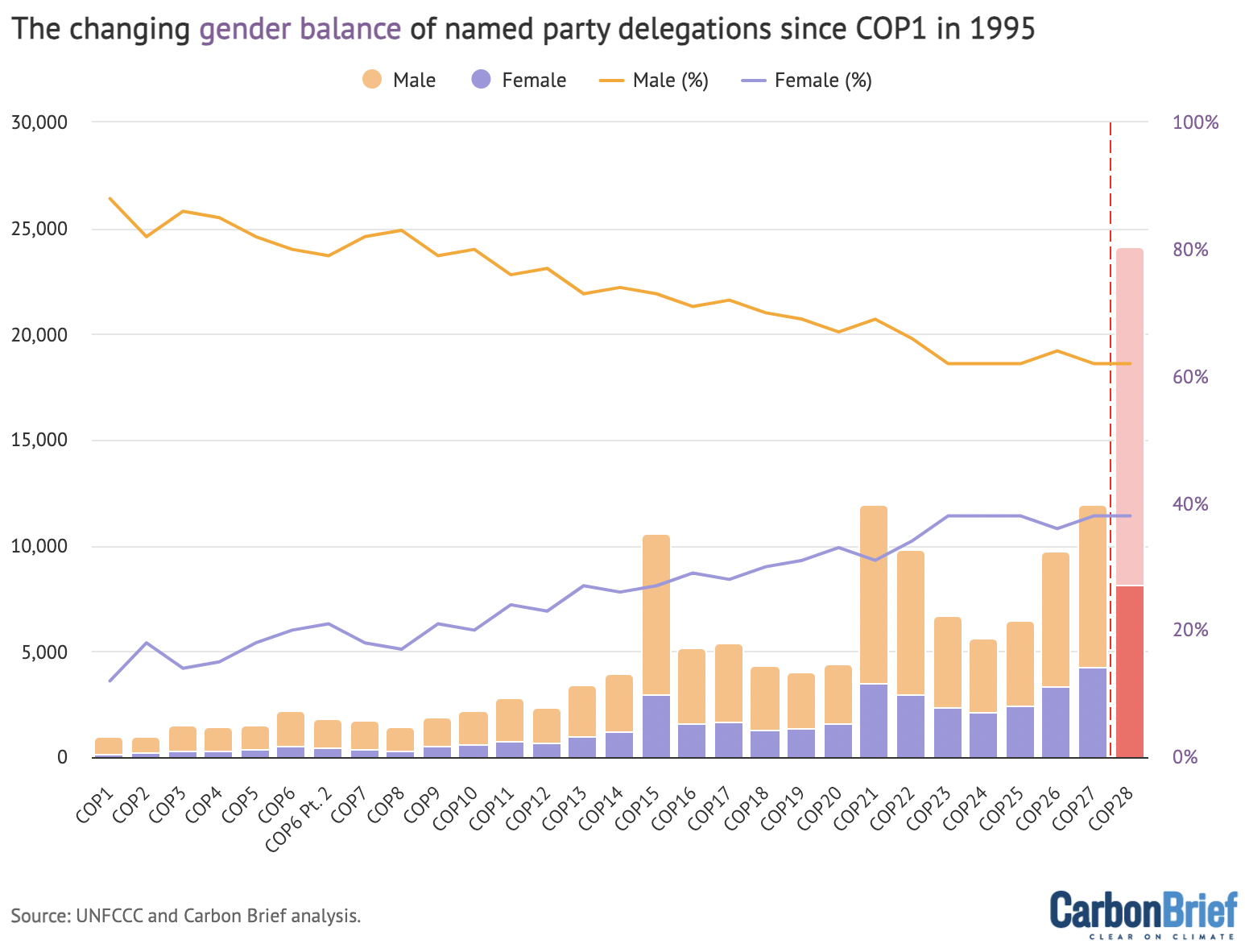
Analysis: Which countries have sent the most delegates to COP28?
Robert McSweeney
12.01.23Robert McSweeney
01.12.2023 | 4:05pmRecord numbers of delegates have been registered for this year’s COP28 climate summit in the United Arab Emirates (UAE), making it potentially the largest in COP history by some distance.
More than 97,000 participants have badges to attend this year’s Conference of the Parties (COP) in Dubai in person.
This is almost twice the number that travelled to Sharm El-Sheikh in Egypt for COP27 last year, the previous largest in an almost 30-year history of summits.
- COP28: Key outcomes agreed at the UN climate talks in Dubai
- COP28: Key outcomes for food, forests, land and nature at the UN climate talks in Dubai
- Webinar: Carbon Brief journalists discuss COP28’s key outcomes
- Guest post: What would an ambitious ‘global goal on adaptation’ look like at COP28?
- Q&A: Why defining the ‘phaseout’ of ‘unabated’ fossil fuels is so important at COP28
- Analysis: Which countries have sent the most delegates to COP28?
- Interactive: Who wants what at the COP28 climate change summit
For the first time in COP history, every single delegate has been named in the participant lists (not including support staff).
Previous COPs have typically seen thousands of “overflow” participants in which countries and UN agencies could nominate delegates without their names appearing on their official lists.
Also named this year are “host country guests” – those receiving badges as guests of the UAE.
Recipients include former UK prime ministers Boris Johnson and Tony Blair, Microsoft co-founder Bill Gates, CEO and chairman of French energy giant EDF Luc Rémont and NATO secretary general Jens Stoltenberg.
This year, also for the first time, 3,000 “virtual-only” participants are named, which takes the overall provisional delegate total for COP28 to more than 100,000.
Unsurprisingly, the UAE has the largest-ever registered delegation of any country, with 4,409 badges. This is followed by Brazil with 3,081 and then China and Nigeria, who have both issued 1,411 badges.
Update: This article was updated on 02/12/2023 to include the full number of support staff (which were not included in the Excel files), which takes the overall total number of participants from 84,000 to more than 100,000.
Update 09/01/2024: The UNFCCC has now published the final COP28 participant lists (including full Excel files). A total of 83,884 people attended in person, plus 2,089 online, taking the total number of participants to almost 86,000. This means COP28 was comfortably the largest climate COP in history – topping COP27 by more than 35,000.
Record numbers
For the first time in COP history, the participant lists have been published by the United Nations Framework Convention on Climate Change (UNFCCC) in spreadsheet format, rather than as pdf documents. (A summary pdf file of the overall participant totals has also now been published.)
The provisional total for COP28 suggests that 97,372 delegates have registered to attend the summit in person. With a further 3,074 attending virtually, this takes the overall total to 100,446.
As the chart below shows, this comfortably makes the Dubai event the largest COP in history. For comparison, the first climate COP – held in Berlin in 1995 – had 3,969 delegates.
Last year’s COP in Sharm El-Sheikh received almost 50,000 delegates, which put it some distance ahead of the 38,000 that attended COP26 in Glasgow in 2021. It highlights a trend of increasing participation at climate COPs following a dip in attendance after the peak of COP21 in Paris in 2015.
It should be noted that these are provisional figures, based on the delegates that have registered for the summit. The UNFCCC will release the final figures – based on participants collecting a physical badge at the venue – after the summit has closed.

As usual, the lists are divided between the different types of groups and organisations attending the summit. The largest group at COP28 is for delegates representing parties. These are nation states, plus the European Union, that have ratified the convention and play a full part in negotiations. This group adds up to 24,488 delegates – more than double the number at COP27 last year.
Unusually, the participant lists for this year also name the “overflow” badges that have been given out. For the UK delegation, examples include 21 members of Prime Minister Rishi Sunak’s press delegation, 16 members of King Charles’s royal household and 18 members of parliament.
For consistency with Carbon Brief’s analysis of previous COPs, the above chart includes this group separately, but the participant lists this year do divide the overflow delegates between groups. Including the overflow numbers takes the total for party representatives to 51,695 – by itself, more than the total number of delegates at any previous COP.
As at COP27, there are no longer any “observer” states now that the Holy See – the government of the Roman Catholic Church, which operates from Vatican City State and is led by the pope as the bishop of Rome – has become a full party to the Convention.
The next-largest group is that of observers from non-governmental organisations (NGOs), which totals 14,338 delegates – again, comfortably the largest for this group in COP history.
Along with the NGOs, there are several other groups that fall into the category of “observer organisations” – such as those participants representing UN bodies, intergovernmental organisations, other agencies and business representatives. These total 3,623 registered delegates – or 4,754 when overflow badges are included.
Finally, another record-breaking group is the number of media delegates – clocking in at 3,972. This total potentially tops the 3,712 media representatives at COP3 in Kyoto in 1997.
UAE largest delegation
The UAE has registered the largest delegation of any party, totalling 4,409 participants – including overflow badges. Even without overflow badges – which hugely swell delegation size – UAE’s group of 620 would be its largest in COP history.
The UAE’s registered delegation at COP27 last year was potentially larger at 1,073 people, but just 436 attended, according to the final lists, putting it second-largest behind Brazil’s delegation of 467.
Brazil has again registered a large delegation for this year’s COP – 3,081 participants including overflow badges – meaning it is only behind UAE for overall delegation size.
Other delegations surpassing 1,000 include China and Nigeria who have both registered 1,411 people, followed by Indonesia with 1,229, Japan 1,067 and Turkey with 1,045.
(It is worth noting that some countries allocate some of their party badges to NGOs, which can artificially inflate the size of their official delegation.)
At the other end of the scale, the smallest delegations have been registered by North Korea (two), Nicaragua (six), Eritrea (seven) and Liechtenstein and Moldova (both eight).
For the third year in a row, both Afghanistan and Myanmar have not registered a delegation to the COP, while San Marino is also not present on the provisional lists this year.
The map and chart below present the delegation size – split between party and overflow badges – for all the countries registered for COP27. The darker the shading, the more delegates that country has signed up. Mouse over the countries to see the number of delegates and the population size.
Gender balance
Along with the names in the participant lists, the UNFCCC also typically provides a title – such as Mr, Ms, Sr or Sra – for each registered participant. In the past, this has allowed Carbon Brief to work out the balance of men to women in the delegations that each country has sent to a COP.
(This analysis always carries the caveat that the titles are designated by UNFCCC and not by Carbon Brief. In addition, Carbon Brief recognises that gender is not best categorised using a binary “male” or “female” label and appreciates that the UNFCCC’s lists may not be wholly accurate.)
However, this year’s lists are slightly different. First, there are a number of participants – particularly, for no obvious reason, in the Canadian delegation – that have not been given a title at all. And other titles that do not indicate gender – such as Dr, Prof, Ambassador and Honourable – have also been used frequently.
Therefore, for this COP28 analysis, these non-gendered titles – which make up around 330 names of more than 24,000 in the list of party delegates – have been excluded.
This gives an average gender balance of party delegations of 62% male to 38% female. The chart below shows how this compares with previous COPs – note that, for consistency, the COP28 figure only includes those on party badges, not overflow ones.
There is just one all-male party delegation this year, which is the two-strong group representing North Korea.

The full list of COP28 party delegation sizes can be found here.





